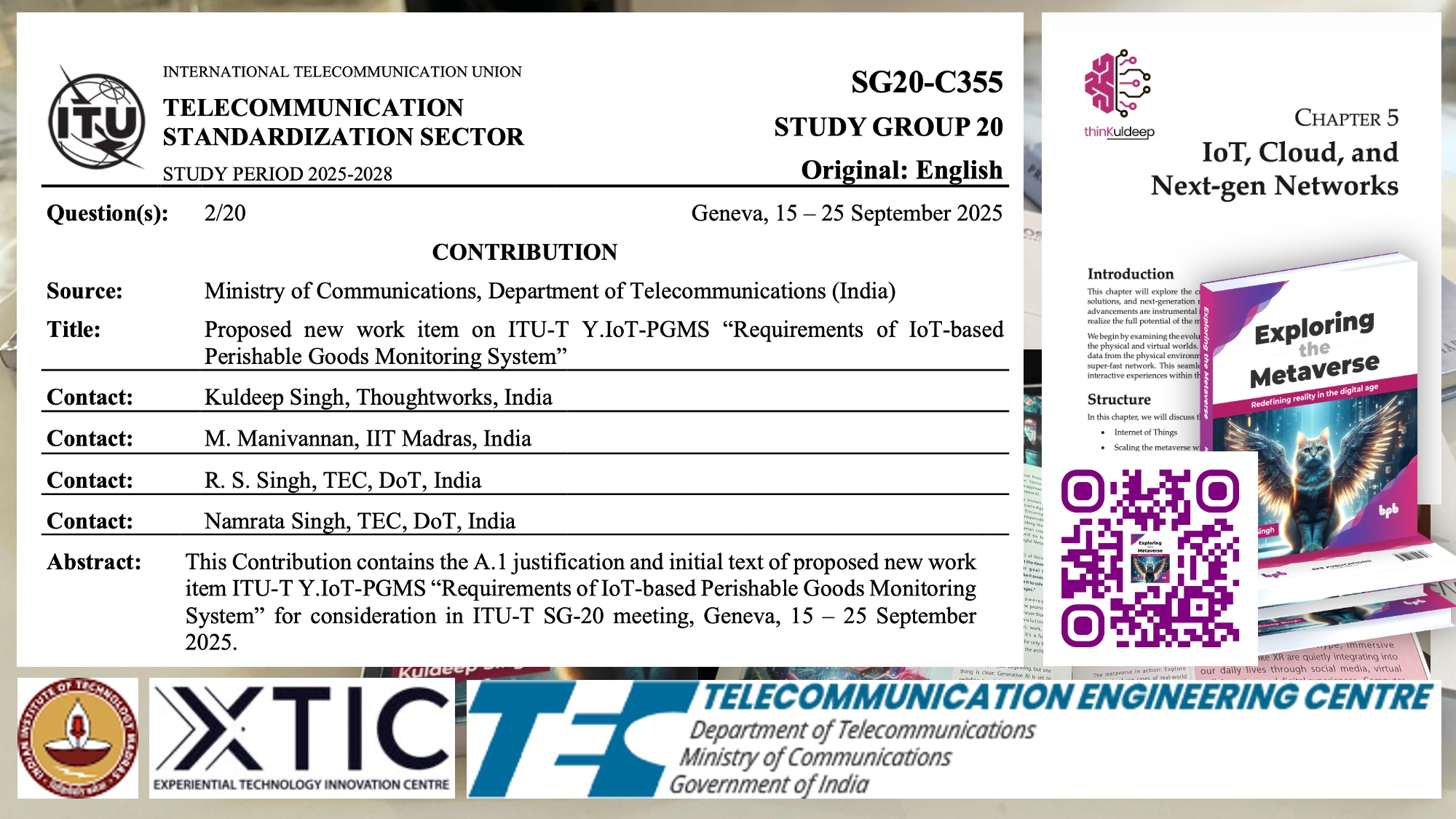ITU-T Technical Report - IoT-based Perishable Goods Monitoring System
- 4 minutes read - 698 wordsRecently, I had the privilege of representing 🇮🇳 India at the International Telecommunication Union Telecommunication Standardization Sector (ITU-T) Study Group 20 (SG20) meeting in Geneva.
I’m pleased to share that my recommendations for standardizing requirements for an IoT-based Perishable Goods Monitoring System has been accepted as an official Technical Report. Here’s a brief overview of the experience and its significance.

About ITU-T Study Group 20
The ITU-T is a global body that develops standards for telecommunications and ICT, bringing together governments, industry leaders, and academia. It has produced well-known standards such as X.509, Y.3172, and H.263.
Study Group 20 (SG20) focuses on IoT, digital twins, and smart sustainable cities. Representing India on behalf of the Department of Telecommunications (DoT), I participated in discussions that shape the future of IoT standards globally.
Together with XTIC, IIT Madras and the Telecommunication Engineering Centre (TEC), I’ve been contributing to various ITU initiatives — find my previous contributions here. For a full summary of the September 2025 SG20 meeting, visit this link.
Six new work items from IoT Division, TEC, were approved at the ITU-T SG-20 meeting (15–25 Sept 2025, Geneva) — a significant achievement for DoT, India. With this, a total of 11 new work items now stands approved from IoT division, TEC. (1/2)
— TEC DoT India (@TEC_DoT_India) October 1, 2025
Context: Safety and Quality of Perishable Goods
The safety and quality of perishable goods — particularly food — depend on maintaining optimal conditions such as temperature, humidity, and air quality. A minor lapse, like a refrigerator door left open, can result in spoilage, economic loss, and health risks.
Retail outlets face unique challenges distinct from warehouses, as product exposure and handling frequency are much higher. Food waste remains a global issue — nearly one-third of all food produced is lost or wasted annually, impacting hunger, economies, and the environment.
This aligns directly with the UN Sustainable Development Goals, especially SDG 2 (Zero Hunger) and SDG 12 (Responsible Consumption and Production). Hence, establishing standards for IoT-enabled monitoring is crucial for both consumer safety and sustainability.
The Draft Recommendation: IoT-based Perishable Goods Monitoring System
While existing standards (like ISO 22000, ISO 22002 series, ISO 23412) and ITU’s Y.IoT-SWMS address warehouse-level monitoring, there was a gap in retail-level implementations.
Along with Prof. M. Manivannan , Mr. R. S. Singh and team, we have proposed a standardising the requirements for IoT-based perishable goods monitoring system for retail environments to ITU earlier, and further refined them this time. These proposals cover real-time tracking, automated alerts, actionable insights, managing iot devices, and reporting mechanisms for quality assurance and compliance.
By integrating IoT sensors into retail operations, this approach ensures proactive spoilage prevention, improved food safety, and reduced waste — ultimately protecting public health and brand integrity.
Accepted as a Technical Report by ITU-T
Following rigorous global review and discussions, ITU-T Study Group 20 accepted our recommendation as a Technical Report. It defines key layers for IoT-based retail monitoring systems — including Sensing, Communication, Integration, Application & Analytics, and Management & Maintenance layers.
This report will serve as a foundational guideline for global adoption and will continue to evolve through the 2025–2028 study period.
- A.13 Justification for proposed new draft Technical Report ITU-T YSTR.IoT-PGMS
- Initial text of proposed new draft Technical Report ITU-T YSTR.IoT-PGMS
Locating and Troubleshooting IoT Devices
Effective device management is key to any IoT deployment. Mapping, locating, and troubleshooting sensors across large area requires spatial intelligence.
In my book 📕 Exploring the Metaverse, I elaborate on spatial management of connected things, discussing how IoT acts as a backbone for the emerging Metaverse of Things — where every device becomes part of a larger, intelligent ecosystem.
As an industry expert at Thoughtworks and an active contributor to Metaverse India Standards and Practices (MIPS), I continue to explore how IoT and XR converge to redefine our digital-physical future.
Acknowledgments
This achievement was made possible through the guidance of Mr. R. S. Singh, Dy. Director General (IoT), TEC, DoT, Ministry of Communications, India and the dedicated TEC team. My sincere gratitude to Prof. M. Manivannan, the MIPS community, and my colleagues at Thoughtworks for their constant encouragement and support.
Keep learning, keep contributing, and keep sharing!
#thoughtworks #event #speaker #talk #iot #community #learnings #ITUT #metaverse #standards #iit #xtic #mips #book #retail #perishable goods #usecase #paper #patent